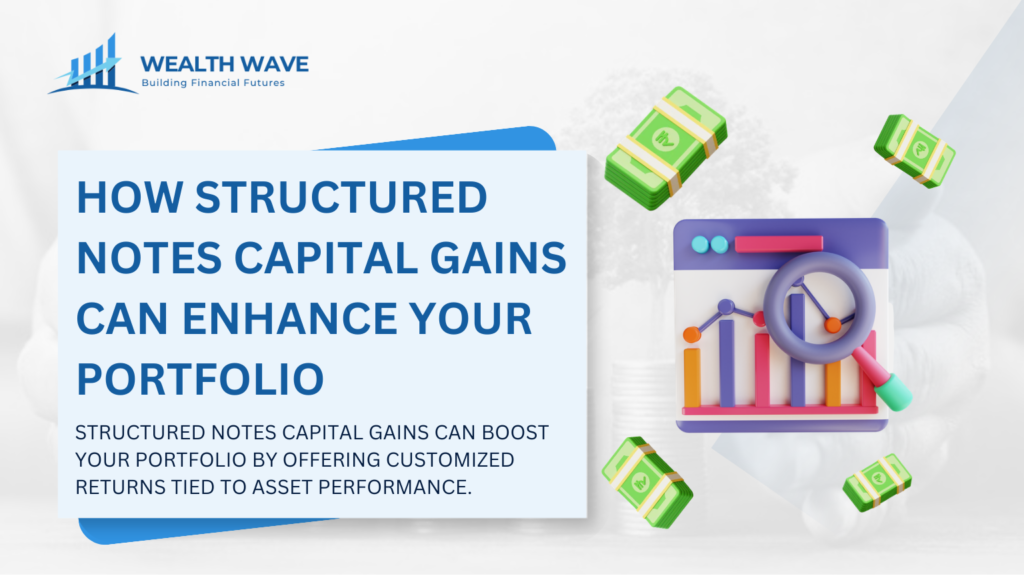
Navigating the investment landscape can definitely feel like deciphering an ancient map at times, especially when you encounter buzzwords like structured notes. These financial instruments promise the allure of potentially high returns linked to a variety of assets, from equity indexes to commodities.
But when it comes down to the brass tacks—like figuring out how gains from structured notes are taxed—it’s easy to get lost in the weeds.
Let me tell you, we’ve done our fair share of head-scratching over these complex debt securities. It was quite the eye-opener finding out that profits from structured notes don’t enjoy the lower capital gains tax rates but are instead taxed as ordinary income.
This little nugget of information sent us on a deep dive to really grasp what structured notes is, their potential benefits, and crucially, how they fit into a savvy taxpayer’s world.
We’re here now with those hard-won insights tucked under our belts, ready to walk you through understanding structured notes better. Beyond just their workings and perks, we’ll delve into key tax considerations so you can smartly incorporate them into your asset allocation and risk management strategy—without any unwanted tax surprises lying in wait.
Brace yourself for some clarity coming your way on the topic of structured notes capital gains.
Key Takeaways for Structured Notes Capital Gains
- Profits from structured notes are taxed as ordinary income, not at the lower capital gains tax rates. This means we pay more in taxes on our investment gains compared to some other investments.
- Structured notes offer principal protection and the chance for higher returns linked to markets like equity indexes or commodities. They’re a good choice for diversifying our portfolio beyond traditional stocks or bonds.
- These investments come with specific risks such as limited liquidity, which can make them hard to sell before maturity, and capped returns, meaning if the market does really well, we might not get all the possible profits.
- Call risk is another factor; if interest rates drop or conditions favor the issuer (like a bank), they might redeem our notes early. This could cut short potential gains we were counting on.
- Despite being potentially more costly due to ordinary income tax rates and various fees associated with their complex structure, structured notes could still be beneficial by offering tailored exposure to certain markets or strategies not easily accessed through standard stocks or mutual funds.
Understanding Structured Notes

Structured notes are unique investment products that combine features of bonds and derivatives. They offer a way to seek returns linked to market performance, making them an interesting choice for those looking to diversify their investments.
Definition and Basic Features

Structured notes are unique debt instruments issued by financial institutions. They provide investors with exposure to various asset classes and investment strategies, such as equity indexes or commodities.
These structured products often come with features like principal protection, ensuring that we receive our initial investment back at maturity, regardless of market performance.
Investors can expect returns based on different underlying assets but should note that gains from structured notes are taxed at the ordinary income rate rather than the lower capital gains rate typically associated with other investment types.
Understanding these basic features helps us appreciate how structured notes function in the context of portfolio management and wealth management strategies. Next, we’ll explore how structured notes work in more detail.
Types of Structured Notes

Structured notes come in various types, each designed to meet different investment objectives. One common type is the equity-linked structured note, where returns are based on equity indexes or specific equities.
These notes often feature an embedded derivative component that allows us to benefit from market movements while potentially securing our principal investment upon maturity. Another option includes commodity-linked structured notes which tie returns to the performance of commodities like oil or gold.
We can also explore fixed-income structured notes that provide interest payments throughout their term, offering a regular income stream instead of solely relying on capital appreciation.
Some structured notes even combine multiple asset classes, making them hybrid securities with opportunities for diversified exposure. Each type serves its purpose and aligns with varying risk appetites and investment strategies in our portfolio management efforts.
How Do Structured Notes Work?

Structured notes combine debt instruments with derivatives. These features create unique investments that can offer different returns based on specific market conditions.
Derivative Component
The derivative component of structured notes plays a crucial role in their functionality. This feature links the note’s performance to an underlying asset, such as equity indexes or commodities.
It allows us to gain exposure to different investment strategies without directly owning those assets. By using derivatives, we can potentially access returns that are linked to market movements while benefiting from features like principal protection.
The returns generated from this component may vary significantly based on the performance of the underlying index or asset. It’s vital for us to understand that these gains might be capped; if an index climbs beyond a certain threshold, we could miss out on additional profits and only receive our principal back at maturity.
Thus, navigating the complexities of structured notes requires careful consideration of both potential gains and risks associated with derivative components.
Embedded Derivative Component
Structured notes often contain an embedded derivative component, which is crucial for their performance. This feature links the note’s returns to specific underlying assets or indices, such as equity indexes or commodities.
Gains from these structured notes can vary based on the performance of that embedded derivative. For instance, if a structured note is tied to an equity index and it performs well, our return may be significantly higher than traditional fixed income investments.
However, we should consider that gains from these instruments might also be capped at a certain percentage outlined in the prospectus.
This means we could receive only our principal back if the index exceeds this limit. The structure does not include an actual underlying portfolio like mutual funds or exchange-traded funds (ETFs); instead, it functions as a hybrid security with properties of both debt obligations and derivatives.
Understanding this embedded aspect helps us better grasp how structured notes operate within our investment strategies while being mindful of associated tax implications and potential risks involved.
Principal Protection
Principal protection is a key feature of structured notes. This means that investors can expect to receive their initial investment amount back at maturity, regardless of market performance.
It offers a safety net during volatile market conditions, which provides peace of mind for those concerned about potential losses. Typically issued by financial institutions, these debt securities link their returns to equity indexes or other underlying assets while ensuring that our principal remains intact.
Gains from structured notes might be capped based on the terms outlined in the prospectus. If an index rises beyond a certain threshold, we may only recover our principal and miss out on additional gains.
Understanding this aspect is crucial as it highlights both the potential upside and limitations associated with investing in structured notes. The taxation of any gains comes at ordinary income rates instead of capital gains rates, which could impact our overall investment strategy when considering taxation implications.
Performance and Cost Considerations

Structured notes can offer unique ways to calculate returns that may differ from traditional investments. We should also consider the potential tax implications, as they can significantly affect our overall profit and investment strategy.
Calculation of Returns
Calculating returns on structured notes often involves understanding their link to underlying assets or indexes. Returns are typically based on equity indexes, single equities, or other assets, and may fluctuate depending on market performance.
While some structured notes provide principal protection—ensuring we receive our initial investment back at maturity—gains can sometimes be capped. The prospectus usually details any limits; for instance, if an index rises beyond a specific threshold, we might only get our principal amount returned without additional gains.
Tax implications also play a crucial role in the return calculation. Structured notes are generally taxed at ordinary income rates rather than the lower capital gains rate. This distinction may significantly affect overall profitability compared to other investment options like exchange-traded funds (ETFs) that have different tax treatments.
Understanding these calculations helps us make informed decisions about including structured notes in our portfolios as we consider their benefits and potential drawbacks next.
Tax Implications
Structured notes present distinct tax implications for investors. Gains from these instruments are typically taxed at the ordinary income rate. This is often higher than the capital gains rate that applies to many other investments, like equity securities.
We should also consider that structured notes can limit our overall gains. If an index rises beyond a specific threshold stated in the prospectus, we may only receive our principal back without any additional returns.
The structure of these debt securities means they do not hold an actual underlying portfolio of investments as funds or exchange-traded funds (ETFs) do. Consequently, their tax treatment differs significantly from traditional assets.
Understanding these nuances helps us make informed decisions about how structured notes fit into our investment strategies and overall portfolio diversification efforts while being mindful of the taxation of investments involved.
Advantages and Disadvantages of Structured Notes

Structured notes can offer unique benefits for investors. They may provide opportunities for higher returns, but they also come with certain risks and challenges that we should seriously consider.
Potential for Higher Returns
Structured notes can offer the potential for higher returns by providing exposure to various underlying assets, such as equity indexes and commodities. We see this as an opportunity because gains are often linked to the performance of these indices, allowing us to participate in market upswings without directly holding the underlying investments like traditional mutual funds or exchange-traded funds (ETFs).
This unique structure allows us to take advantage of favorable market conditions while still enjoying features like principal protection. Investors can benefit from a range of possible outcomes based on how well these indexes perform, although it’s important to remember that some structured notes may cap our returns if certain thresholds are exceeded.
Limited Liquidity
Limited liquidity poses a challenge for investors in structured notes. These financial products, issued by banks as a means to raise funds, often lack a secondary market. As a result, selling them before maturity can be difficult and may lead to price discounts.
Unlike exchange-traded funds (ETFs) or mutual funds that offer greater flexibility for buying and selling, structured notes are not designed for active trading. This limited ability to liquidate investments can hinder our access to cash when needed or affect our overall investment strategy.
Investors should also consider pricing rigidity in the context of limited liquidity. With returns potentially capped as stated in the prospectus—where gains might only reflect the principal if an index rises beyond a set percentage—our options become even more restricted if we wish to exit early.
This limitation emphasizes the importance of understanding how structured notes fit within our broader portfolio goals and risk tolerance while navigating their unique characteristics, including tax implications tied with ordinary income rates versus capital gains rates.
Pricing Rigidity
The discussion on limited liquidity flows naturally into pricing rigidity. Structured notes can exhibit significant price inflexibility. This can make it challenging for investors to sell their structured notes at desired prices before maturity.
The yields and returns are closely tied to the performance of an underlying asset or index, such as equity indexes or commodities. Since these instruments do not hold a portfolio like mutual funds or exchange-traded funds (ETFs), they may be less responsive to market movements.
Cap scenarios also contribute to this issue. Gains from structured notes are often capped; if the index appreciates beyond a specified percentage, we could miss out on potential profits.
Furthermore, banks issue these debt securities primarily for fundraising purposes, meaning that our opportunities for capitalizing on immediate market trends diminish due to their rigid pricing structures.
Call Risk
Call risk arises with structured notes when the issuer retains the right to redeem them before maturity. This can happen if interest rates drop or if market conditions favor the bank’s position.
We may face unexpected outcomes since our potential for gains can suddenly diminish. If a structured note gets called, we might miss out on higher returns, especially if linked to equity indexes performing well.
Understanding this risk helps us gauge how structured notes fit within our investment strategy. Evaluating call risk alongside other factors will support more informed decisions about these financial instruments and their overall role in our portfolio diversification strategy.
Fees
Fees associated with structured notes can significantly impact our overall returns. Banks issue these debt securities to raise funds, but they often include various costs that we need to consider.
These fees may cover underwriting, management, and other administrative expenses tied to the note’s structure. Unlike mutual funds or exchange-traded funds (ETFs), which typically have transparent fee structures, structured notes may present challenges in assessing total costs upfront.
Tax implications also add another layer of expense since gains from structured notes are taxed at ordinary income rates rather than the lower capital gains rate. Understanding all these fees is crucial for us as investors because it directly affects our net returns and overall investment strategy when considering capital gains from structured notes.
Taxation
Tax considerations play a crucial role in our investment strategy. Gains from structured notes are typically taxed at the ordinary income rate, unlike capital gains which may have a lower tax rate.
This means that when we realize profits from these debt instruments, we could face higher tax liabilities. It’s essential to keep this difference in mind as we evaluate investments like structured notes linked to equity indexes or other underlying assets.
Structured notes often come with capped returns, meaning if the index surpasses a specific percentage increase, we might miss out on extra gains and only recover our principal. Understanding how these aspects impact our overall return is vital for making informed decisions about portfolio diversification and managing taxation effectively.
How Structured Notes Can Help Diversify Your Portfolio

Structured notes offer unique investment opportunities that can enhance our portfolio’s diversity. These instruments blend different asset classes, allowing us to explore various market strategies.
They provide exposure to equity indexes while managing risk differently than traditional investments. Incorporating structured notes can lead us to new prospects in our investment journey.
There’s so much more to understand about how they fit into a broader strategy!
Benefits of Adding Structured Notes to your Investment Portfolio
Adding structured notes to our investment portfolio offers unique benefits. These debt securities allow us to earn returns based on equity indexes, commodities, or other underlying assets.
With features like principal protection, we can be assured of receiving our initial investment back at maturity, regardless of market performance. Structured notes can diversify our exposure beyond traditional mutual funds or exchange-traded funds (ETFs) while providing the potential for higher returns.
While gains from structured notes are usually taxed at ordinary income rates rather than the lower capital gains rate, they still present an opportunity for tailored investments linked to specific asset classes and strategies.
The flexibility and variety offered by these instruments enable us to craft a strategy that aligns with our financial goals. As banks issue structured notes to raise funds and cater to different investor needs, incorporating them into our portfolios can enhance overall performance and risk management.
How Structured Notes differ from Other Investment Options
Structured notes stand apart from traditional investment options like mutual funds or exchange-traded funds (ETFs). These debt securities do not maintain an actual underlying portfolio of investments.
Instead, their returns link directly to equity indexes, commodities, or other assets. While structured notes can provide principal protection—ensuring we get back our initial investment at maturity irrespective of market performance—their gains are typically taxed as ordinary income rather than the lower capital gains rate.
Investing in structured notes can lead to capped growth potential. The prospectus may indicate that if an index rises beyond a specific percentage, we will only receive our principal and miss any additional profits.
This characteristic distinguishes them from more conventional equities where unlimited upside potential exists. Understanding these differences helps us make informed decisions about how structured notes might fit within our overall investment strategy.
Conclusion

We’ve explored how structured notes function as unique investment vehicles that link returns to various underlying assets. These instruments provide potential benefits, such as principal protection and higher returns based on equity indexes, but also come with taxation at ordinary income rates.
It’s crucial for us to consider the implications of these features when evaluating our portfolios. How can we effectively integrate structured notes into our investment strategies? By understanding their advantages and limitations, we can make informed decisions about diversifying our investments.
As we navigate this landscape, let’s stay proactive in seeking knowledge and opportunities that align with our financial goals.
FAQs
Q1. What are structured notes capital gains?
Ans. Structured notes capital gains refer to the profit made from selling structured notes at a higher price than what they were bought for.
Q2. How does an Exchange-traded fund (ETF) relate to structured notes?
Ans. An ETF can be linked with structured notes, offering returns based on equity indexes. The performance of the ETF influences the return on your investment in the note.
Q3. Can you explain constructive ownership transactions in relation to structured notes?
Ans. Constructive ownership transactions occur when investors indirectly hold a position in a security, like through structured notes, and earn profits or losses based on its performance.
Q4. Are returns from structured notes always tied to equity indexes?
Ans. No, not all returns from structured notes are based on equity indexes; it depends upon how the note is constructed and what assets it's linked with.




